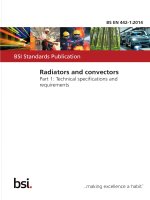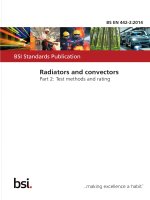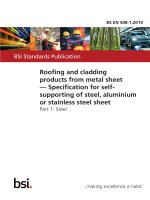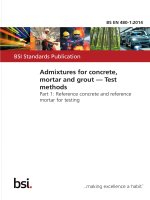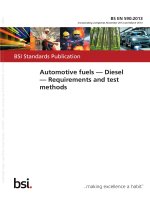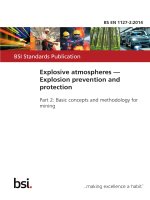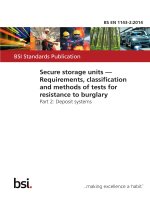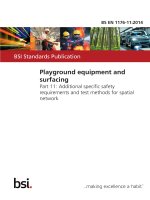Bsi bs en 61970 301 2014
Bạn đang xem bản rút gọn của tài liệu. Xem và tải ngay bản đầy đủ của tài liệu tại đây (5.38 MB, 376 trang )
BS EN 61970-301:2014
BSI Standards Publication
Energy management
system application program
interface (EMS-API)
Part 301: Common information model
(CIM) base
BS EN 61970-301:2014 BRITISH STANDARD
National foreword
This British Standard is the UK implementation of EN 61970-301:2014. It
is identical to IEC 61970-301:2013. It supersedes BS EN 61970-301:2013
which is withdrawn.
The UK participation in its preparation was entrusted to Technical
Committee PEL/57, Power systems management and associated
information exchange.
A list of organizations represented on this committee can be obtained on
request to its secretary.
This publication does not purport to include all the necessary provisions of
a contract. Users are responsible for its correct application.
© The British Standards Institution 2014.
Published by BSI Standards Limited 2014
ISBN 978 0 580 81664 2
ICS 33.200
Compliance with a British Standard cannot confer immunity from
legal obligations.
This British Standard was published under the authority of the
Standards Policy and Strategy Committee on 31 August 2014.
Amendments/corrigenda issued since publication
Date Text affected
EUROPEAN STANDARD BS EN 61970-301:2014
NORME EUROPÉENNE
EUROPÄISCHE NORM EN 61970-301
ICS 33.200 July 2014
Supersedes EN 61970-301:2013
English Version
Energy management system application program interface
(EMS-API) - Part 301: Common information model (CIM) base
(IEC 61970-301:2013)
Interface de programmation d'application pour système de Schnittstelle für Anwendungsprogramme für
gestion d'énergie (EMS-API) - Part 301: Base de modèle Netzführungssysteme (EMS-API) - Teil 301: Allgemeines
d'information commun (CIM) Informationsmodell (CIM)
(CEI 61970-301:2013) (IEC 61970-301:2013)
This European Standard was approved by CENELEC on 2014-01-17. CENELEC members are bound to comply with the CEN/CENELEC
Internal Regulations which stipulate the conditions for giving this European Standard the status of a national standard without any alteration.
Up-to-date lists and bibliographical references concerning such national standards may be obtained on application to the CEN-CENELEC
Management Centre or to any CENELEC member.
This European Standard exists in three official versions (English, French, German). A version in any other language made by translation
under the responsibility of a CENELEC member into its own language and notified to the CEN-CENELEC Management Centre has the
same status as the official versions.
CENELEC members are the national electrotechnical committees of Austria, Belgium, Bulgaria, Croatia, Cyprus, the Czech Republic,
Denmark, Estonia, Finland, Former Yugoslav Republic of Macedonia, France, Germany, Greece, Hungary, Iceland, Ireland, Italy, Latvia,
Lithuania, Luxembourg, Malta, the Netherlands, Norway, Poland, Portugal, Romania, Slovakia, Slovenia, Spain, Sweden, Switzerland,
Turkey and the United Kingdom.
European Committee for Electrotechnical Standardization
Comité Européen de Normalisation Electrotechnique
Europäisches Komitee für Elektrotechnische Normung
CEN-CENELEC Management Centre: Avenue Marnix 17, B-1000 Brussels
© 2014 CENELEC All rights of exploitation in any form and by any means reserved worldwide for CENELEC Members.
Ref. No. EN 61970-301:2014 E
BS EN 61970-301:2014
EN 61970-301:2014 - 2 -
Foreword
The text of document 57/1395/FDIS, future edition 5 of IEC 61970-301, prepared by IEC TC 57 "Power
systems management and associated information exchange" was submitted to the IEC-CENELEC
parallel vote and approved by CENELEC as EN 61970-301:2014.
The following dates are fixed:
• latest date by which the document has (dop) 2015-01-18
to be implemented at national level by (dow) 2017-01-17
publication of an identical national
standard or by endorsement
• latest date by which the national
standards conflicting with the
document have to be withdrawn
This document supersedes EN 61970-301:2013.
Attention is drawn to the possibility that some of the elements of this document may be the subject of
patent rights. CENELEC [and/or CEN] shall not be held responsible for identifying any or all such patent
rights.
This document has been prepared under a mandate given to CENELEC by the European Commission
and the European Free Trade Association.
Endorsement notice
The text of the International Standard IEC 61970-301:2013 was approved by CENELEC as a European
Standard without any modification.
In the official version, for Bibliography, the following notes have to be added for the standards indicated:
IEC 61968-11 NOTE Harmonised in EN 61968-11.
IEC 61970-501 NOTE Harmonised as EN 61970-501.
BS EN 61970-301:2014
- 3 - EN 61970-301:2014
Annex ZA
(normative)
Normative references to international publications
with their corresponding European publications
The following documents, in whole or in part, are normatively referenced in this document and are
indispensable for its application. For dated references, only the edition cited applies. For undated
references, the latest edition of the referenced document (including any amendments) applies.
NOTE When an international publication has been modified by common modifications, indicated by (mod), the relevant EN/HD
applies.
Publication Year Title EN/HD Year
- -
IEC 60050 (Series) International Electrotechnical Vocabulary EN 60870-6 (Series)
(IEV)
EN 61850 (Series)
IEC 60870-6 (Series) Telecontrol equipment and systems - EN 61850-7-3 2011
Part 6-802: Telecontrol protocols compatible
with ISO standards and ITU-T EN 61850-7-4 2010
recommendations - TASE.2 Object models
EN 61968 (Series)
IEC 61850 (Series) Communication networks and systems for CLC/TS 61970-2
power utility automation EN 62325 (Series)
- -
IEC 61850-7-3 2010 Communication networks and systems for
power utility automation -
Part 7-3: Basic communication structure -
Common data classes
IEC 61850-7-4 2010 Communication networks and systems for
power utility automation -
Part 7-4: Basic communication structure -
Compatible logical node classes and data
object classes
IEC 61968 (Series) Application integration at electric utilities -
System interfaces for distribution
management
IEC/TS 61970-2 Energy management system application
program interface (EMS-API) -
Part 2: Glossary
IEC 62325 (Series) Framework for energy market
communications
UML 2.0 - Object Object Management Group: UML 2.0
Group Management Specification
– 2 – BS EN 61970-301:2014
61970-301 IEC:2013
CONTENTS
INTRODUCTION................................................................................................................... 29
1 Scope ............................................................................................................................ 31
2 Normative references .................................................................................................... 31
3 Terms and definitions .................................................................................................... 32
4 CIM specification ........................................................................................................... 33
4.1 CIM modeling notation .....................................................................................33
4.2 CIM packages .................................................................................................. 33
4.3 CIM classes and relationships..........................................................................35
4.3.1 Classes .......................................................................................... 35
4.3.2 Generalization ................................................................................ 36
4.3.3 Simple association..........................................................................37
4.3.4 Aggregation .................................................................................... 37
4.4 CIM model concepts and examples ..................................................................38
4.4.1 Concepts ........................................................................................ 38
4.4.2 Containment, equipment hierarchies and naming............................38
4.4.3 Names model .................................................................................40
4.4.4 Connectivity model .........................................................................41
4.4.5 Inheritance hierarchy ......................................................................44
4.4.6 Transformer model .........................................................................45
4.4.7 Transformer tap modeling ...............................................................48
4.4.8 Phase wire modeling ......................................................................52
4.4.9 Cuts, clamps and jumpers model ....................................................53
4.4.10 Measurements and controls ............................................................56
4.4.11 Regulating control models ..............................................................61
4.5 Modeling guidelines ......................................................................................... 62
4.5.1 Modeling for change .......................................................................62
4.5.2 Process for amendments to the CIM ...............................................62
4.5.3 Changes to the CIM UML model .....................................................63
4.5.4 Changes to the CIM standards documents ......................................63
4.5.5 Deprecations .................................................................................. 63
4.5.6 CIM profiles .................................................................................... 63
4.6 Modeling tools ................................................................................................. 64
4.7 User implementation conventions.....................................................................64
4.7.1 Conventions beyond UML ............................................................... 64
4.7.2 Number of Terminals for ConductingEquipment objects ..................64
4.8 CIM modeling examples ...................................................................................64
5 Detailed model .............................................................................................................. 65
5.1 Overview.......................................................................................................... 65
5.2 Context ............................................................................................................ 65
6 Top package IEC61970 ................................................................................................. 67
6.1 General............................................................................................................ 67
6.2 IEC61970CIMVersion root class.......................................................................67
6.3 Package Domain..............................................................................................68
6.3.1 General .......................................................................................... 68
6.3.2 ActivePower datatype ..................................................................... 73
BS EN 61970-301:2014 – 3 –
61970-301 IEC:2013
6.3.3 ActivePowerChangeRate datatype .................................................. 73
6.3.4 Admittance datatype ....................................................................... 73
6.3.5 AngleDegrees datatype .................................................................. 73
6.3.6 AngleRadians datatype ................................................................... 74
6.3.7 ApparentPower datatype................................................................. 74
6.3.8 Boolean primitive ............................................................................74
6.3.9 Capacitance datatype ..................................................................... 74
6.3.10 Conductance datatype .................................................................... 75
6.3.11 ConductancePerLength datatype .................................................... 75
6.3.12 CostPerEnergyUnit datatype ........................................................... 75
6.3.13 CostPerVolume datatype ................................................................ 75
6.3.14 CostRate datatype .......................................................................... 76
6.3.15 Currency enumeration ....................................................................76
6.3.16 CurrentFlow datatype ..................................................................... 77
6.3.17 Damping datatype........................................................................... 77
6.3.18 Date primitive .................................................................................78
6.3.19 DateInterval compound ...................................................................78
6.3.20 DateTime primitive..........................................................................78
6.3.21 DateTimeInterval compound ...........................................................78
6.3.22 Decimal primitive ............................................................................78
6.3.23 Displacement datatype ................................................................... 78
6.3.24 Duration primitive ...........................................................................79
6.3.25 Float primitive .................................................................................79
6.3.26 FloatQuantity datatype.................................................................... 79
6.3.27 Frequency datatype ........................................................................ 79
6.3.28 Hours datatype ............................................................................... 79
6.3.29 Impedance datatype ....................................................................... 80
6.3.30 Inductance datatype ....................................................................... 80
6.3.31 Integer primitive..............................................................................80
6.3.32 IntegerQuantity datatype ................................................................ 80
6.3.33 KiloActivePower datatype ............................................................... 80
6.3.34 Length datatype .............................................................................. 81
6.3.35 Minutes datatype ............................................................................ 81
6.3.36 Money datatype .............................................................................. 81
6.3.37 PU datatype.................................................................................... 81
6.3.38 PerCent datatype............................................................................ 82
6.3.39 Pressure datatype .......................................................................... 82
6.3.40 Reactance datatype ........................................................................ 82
6.3.41 ReactancePerLength datatype ........................................................ 83
6.3.42 ReactivePower datatype ................................................................. 83
6.3.43 RealEnergy datatype ...................................................................... 83
6.3.44 Resistance datatype ....................................................................... 83
6.3.45 ResistancePerLength datatype ....................................................... 84
6.3.46 RotationSpeed datatype ................................................................. 84
6.3.47 Seconds datatype ........................................................................... 84
6.3.48 Speed datatype .............................................................................. 85
6.3.49 String primitive ...............................................................................85
6.3.50 StringQuantity datatype .................................................................. 85
6.3.51 Susceptance datatype .................................................................... 85
– 4 – BS EN 61970-301:2014
61970-301 IEC:2013
6.3.52 SusceptancePerLength datatype .................................................... 86
6.3.53 Temperature datatype..................................................................... 86
6.3.54 Time primitive .................................................................................86
6.3.55 TimeInterval compound ..................................................................86
6.3.56 UnitMultiplier enumeration ..............................................................87
6.3.57 UnitSymbol enumeration ................................................................. 87
6.3.58 Voltage datatype............................................................................. 88
6.3.59 VoltagePerReactivePower datatype ................................................ 88
6.3.60 Volume datatype............................................................................. 89
6.3.61 VolumeFlowRate datatype .............................................................. 89
6.3.62 WaterLevel datatype ....................................................................... 89
6.3.63 Weight datatype.............................................................................. 89
6.4 Package Core .................................................................................................. 90
6.4.1 General .......................................................................................... 90
6.4.2 BasePower ..................................................................................... 94
6.4.3 BaseVoltage ................................................................................... 94
6.4.4 BasicIntervalSchedule ....................................................................95
6.4.5 Bay ................................................................................................. 96
6.4.6 BreakerConfiguration enumeration..................................................97
6.4.7 BusbarConfiguration enumeration...................................................97
6.4.8 ConductingEquipment ..................................................................... 97
6.4.9 ConnectivityNode............................................................................ 98
6.4.10 ConnectivityNodeContainer ............................................................ 99
6.4.11 Curve ............................................................................................. 99
6.4.12 CurveData root class .................................................................... 100
6.4.13 CurveStyle enumeration ............................................................... 101
6.4.14 Equipment .................................................................................... 101
6.4.15 EquipmentContainer ..................................................................... 102
6.4.16 GeographicalRegion ..................................................................... 103
6.4.17 IdentifiedObject root class ............................................................ 103
6.4.18 IrregularIntervalSchedule.............................................................. 104
6.4.19 IrregularTimePoint root class ........................................................ 105
6.4.20 Name root class............................................................................ 105
6.4.21 NameType root class .................................................................... 106
6.4.22 NameTypeAuthority root class ...................................................... 106
6.4.23 OperatingParticipant ..................................................................... 107
6.4.24 OperatingShare root class ............................................................ 107
6.4.25 PhaseCode enumeration............................................................... 108
6.4.26 PowerSystemResource ................................................................. 109
6.4.27 PsrList .......................................................................................... 109
6.4.28 PSRType ...................................................................................... 110
6.4.29 RegularIntervalSchedule............................................................... 110
6.4.30 RegularTimePoint root class ......................................................... 111
6.4.31 ReportingGroup ............................................................................ 112
6.4.32 ReportingSuperGroup ................................................................... 112
6.4.33 SubGeographicalRegion ............................................................... 113
6.4.34 Substation .................................................................................... 113
6.4.35 Terminal ....................................................................................... 114
6.4.36 VoltageLevel................................................................................. 115
BS EN 61970-301:2014 – 5 –
61970-301 IEC:2013
6.5 Package DiagramLayout ................................................................................ 116
6.5.1 General ........................................................................................ 116
6.5.2 Diagram........................................................................................ 117
6.5.3 DiagramObject.............................................................................. 118
6.5.4 DiagramObjectGluePoint root class .............................................. 119
6.5.5 DiagramObjectPoint root class...................................................... 119
6.5.6 DiagramObjectStyle ...................................................................... 120
6.5.7 OrientationKind enumeration ........................................................ 120
6.5.8 TextDiagramObject ....................................................................... 120
6.5.9 VisibilityLayer ............................................................................... 121
6.6 Package OperationalLimits ............................................................................ 122
6.6.1 General ........................................................................................ 122
6.6.2 ActivePowerLimit .......................................................................... 123
6.6.3 ApparentPowerLimit...................................................................... 124
6.6.4 BranchGroup ................................................................................ 125
6.6.5 BranchGroupTerminal root class................................................... 125
6.6.6 CurrentLimit.................................................................................. 126
6.6.7 OperationalLimit ........................................................................... 126
6.6.8 OperationalLimitDirectionKind enumeration .................................. 127
6.6.9 OperationalLimitSet ...................................................................... 127
6.6.10 OperationalLimitType.................................................................... 128
6.6.11 VoltageLimit ................................................................................. 128
6.7 Package Topology ......................................................................................... 129
6.7.1 General ........................................................................................ 129
6.7.2 BusNameMarker ........................................................................... 133
6.7.3 TopologicalIsland.......................................................................... 134
6.7.4 TopologicalNode........................................................................... 135
6.8 Package Wires............................................................................................... 136
6.8.1 General ........................................................................................ 136
6.8.2 ACLineSegment............................................................................ 149
6.8.3 ACLineSegmentPhase .................................................................. 151
6.8.4 AsynchronousMachine .................................................................. 152
6.8.5 Breaker......................................................................................... 154
6.8.6 BusbarSection .............................................................................. 155
6.8.7 Clamp........................................................................................... 156
6.8.8 CompositeSwitch .......................................................................... 157
6.8.9 CompositeSwitchType datatype .................................................... 158
6.8.10 Conductor..................................................................................... 158
6.8.11 Connector..................................................................................... 159
6.8.12 CoolantType enumeration ............................................................. 160
6.8.13 Cut ............................................................................................... 160
6.8.14 DCLineSegment ........................................................................... 162
6.8.15 Disconnector ................................................................................ 163
6.8.16 EnergyConsumer .......................................................................... 164
6.8.17 EnergyConsumerPhase ................................................................ 166
6.8.18 EnergySource ............................................................................... 166
6.8.19 FrequencyConverter ..................................................................... 167
6.8.20 Fuse ............................................................................................. 169
6.8.21 Ground ......................................................................................... 170
– 6 – BS EN 61970-301:2014
61970-301 IEC:2013
6.8.22 GroundDisconnector ..................................................................... 171
6.8.23 Jumper ......................................................................................... 172
6.8.24 Junction........................................................................................ 173
6.8.25 Line .............................................................................................. 174
6.8.26 LoadBreakSwitch .......................................................................... 175
6.8.27 MutualCoupling............................................................................. 176
6.8.28 OperatingMode datatype............................................................... 177
6.8.29 PerLengthImpedance.................................................................... 177
6.8.30 PerLengthPhaseImpedance .......................................................... 178
6.8.31 PerLengthSequenceImpedance .................................................... 179
6.8.32 PhaseImpedanceData root class................................................... 179
6.8.33 PhaseShuntConnectionKind enumeration ..................................... 180
6.8.34 PhaseTapChanger ........................................................................ 180
6.8.35 PhaseTapChangerAsymetrical ...................................................... 181
6.8.36 PhaseTapChangerLinear .............................................................. 183
6.8.37 PhaseTapChangerNonLinear ........................................................ 184
6.8.38 PhaseTapChangerSymetrical........................................................ 185
6.8.39 PhaseTapChangerTabular ............................................................ 186
6.8.40 PhaseTapChangerTabularPoint root class .................................... 186
6.8.41 Plant............................................................................................. 187
6.8.42 PowerTransformer ........................................................................ 188
6.8.43 PowerTransformerEnd .................................................................. 190
6.8.44 ProtectedSwitch............................................................................ 192
6.8.45 RatioTapChanger ......................................................................... 193
6.8.46 RatioTapChangerTabular.............................................................. 194
6.8.47 RatioTapChangerTabularPoint root class ...................................... 195
6.8.48 ReactiveCapabilityCurve............................................................... 196
6.8.49 Recloser ....................................................................................... 197
6.8.50 RectifierInverter ............................................................................ 198
6.8.51 RegulatingCondEq........................................................................ 199
6.8.52 RegulatingControl ......................................................................... 200
6.8.53 RegulatingControlModeKind enumeration ..................................... 201
6.8.54 RegulationSchedule...................................................................... 202
6.8.55 Resistor ........................................................................................ 203
6.8.56 RotatingMachine........................................................................... 203
6.8.57 Sectionaliser................................................................................. 205
6.8.58 SeriesCompensator ...................................................................... 206
6.8.59 ShuntCompensator ....................................................................... 207
6.8.60 ShuntCompensatorPhase ............................................................. 209
6.8.61 SinglePhaseKind enumeration ...................................................... 210
6.8.62 StaticVarCompensator .................................................................. 210
6.8.63 SVCControlMode enumeration...................................................... 211
6.8.64 Switch .......................................................................................... 212
6.8.65 SwitchPhase ................................................................................. 213
6.8.66 SwitchSchedule ............................................................................ 214
6.8.67 SynchronousGeneratorType enumeration ..................................... 215
6.8.68 SynchronousMachine.................................................................... 215
6.8.69 SynchronousMachineOperatingMode enumeration........................ 218
6.8.70 SynchronousMachineType enumeration........................................ 219
BS EN 61970-301:2014 – 7 –
61970-301 IEC:2013
6.8.71 TapChanger.................................................................................. 219
6.8.72 TapChangerControl ...................................................................... 220
6.8.73 TapChangerKind enumeration ...................................................... 221
6.8.74 TapSchedule ................................................................................ 221
6.8.75 TransformerControlMode enumeration .......................................... 222
6.8.76 TransformerCoreAdmittance ......................................................... 222
6.8.77 TransformerEnd............................................................................ 223
6.8.78 TransformerMeshImpedance ........................................................ 225
6.8.79 TransformerStarImpedance .......................................................... 225
6.8.80 TransformerTank .......................................................................... 226
6.8.81 TransformerTankEnd .................................................................... 227
6.8.82 VoltageControlZone ...................................................................... 228
6.8.83 WindingConnection enumeration .................................................. 229
6.9 Package Generation ...................................................................................... 229
6.10
6.9.1 General ........................................................................................ 229
6.11
6.12 6.9.2 Package GenerationDynamics ...................................................... 230
6.9.3 Package Production...................................................................... 246
Package LoadModel....................................................................................... 294
6.10.1 General ........................................................................................ 294
6.10.2 ConformLoad ................................................................................ 295
6.10.3 ConformLoadGroup ...................................................................... 296
6.10.4 ConformLoadSchedule ................................................................. 297
6.10.5 DayType ....................................................................................... 298
6.10.6 EnergyArea .................................................................................. 298
6.10.7 LoadArea ...................................................................................... 299
6.10.8 LoadGroup ................................................................................... 299
6.10.9 LoadResponseCharacteristic ........................................................ 300
6.10.10 NonConformLoad.......................................................................... 301
6.10.11 NonConformLoadGroup ................................................................ 302
6.10.12 NonConformLoadSchedule ........................................................... 303
6.10.13 PowerCutZone .............................................................................. 304
6.10.14 Season root class ......................................................................... 304
6.10.15 SeasonDayTypeSchedule ............................................................. 305
6.10.16 SeasonName enumeration............................................................ 305
6.10.17 StationSupply ............................................................................... 306
6.10.18 SubLoadArea................................................................................ 307
Package Outage ............................................................................................ 308
6.11.1 General ........................................................................................ 308
6.11.2 ClearanceTag ............................................................................... 309
6.11.3 ClearanceTagType ....................................................................... 310
6.11.4 OutageSchedule ........................................................................... 311
6.11.5 SwitchingOperation....................................................................... 311
6.11.6 SwitchState enumeration .............................................................. 312
Package AuxiliaryEquipment .......................................................................... 312
6.12.1 General ........................................................................................ 312
6.12.2 AuxiliaryEquipment ....................................................................... 313
6.12.3 CurrentTransformer ...................................................................... 314
6.12.4 FaultIndicator ............................................................................... 315
6.12.5 PostLineSensor ............................................................................ 316
– 8 – BS EN 61970-301:2014
61970-301 IEC:2013
6.13 6.12.6 PotentialTransformer .................................................................... 317
6.14 6.12.7 Sensor .......................................................................................... 318
6.15 6.12.8 SurgeProtector ............................................................................. 319
Package Protection ........................................................................................ 320
6.16 6.13.1 General ........................................................................................ 320
6.13.2 CurrentRelay ................................................................................ 321
6.13.3 ProtectionEquipment .................................................................... 322
6.13.4 RecloseSequence......................................................................... 323
6.13.5 SynchrocheckRelay ...................................................................... 324
Package Equivalents...................................................................................... 325
6.14.1 General ........................................................................................ 325
6.14.2 EquivalentBranch ......................................................................... 325
6.14.3 EquivalentEquipment .................................................................... 326
6.14.4 EquivalentInjection ....................................................................... 327
6.14.5 EquivalentNetwork ........................................................................ 328
6.14.6 EquivalentShunt ........................................................................... 329
Package Meas ............................................................................................... 330
6.15.1 General ........................................................................................ 330
6.15.2 Accumulator ................................................................................. 333
6.15.3 AccumulatorLimit .......................................................................... 334
6.15.4 AccumulatorLimitSet ..................................................................... 335
6.15.5 AccumulatorValue......................................................................... 335
6.15.6 Analog .......................................................................................... 336
6.15.7 AnalogLimit................................................................................... 337
6.15.8 AnalogLimitSet ............................................................................. 337
6.15.9 AnalogValue ................................................................................. 338
6.15.10 Command ..................................................................................... 339
6.15.11 Control ......................................................................................... 340
6.15.12 ControlType .................................................................................. 341
6.15.13 Discrete ........................................................................................ 341
6.15.14 DiscreteValue ............................................................................... 342
6.15.15 Limit ............................................................................................. 343
6.15.16 LimitSet ........................................................................................ 343
6.15.17 Measurement................................................................................ 344
6.15.18 MeasurementValue ....................................................................... 345
6.15.19 MeasurementValueQuality ............................................................ 346
6.15.20 MeasurementValueSource ............................................................ 347
6.15.21 Quality61850 root class ................................................................ 348
6.15.22 SetPoint........................................................................................ 348
6.15.23 StringMeasurement....................................................................... 349
6.15.24 StringMeasurementValue.............................................................. 350
6.15.25 Validity enumeration ..................................................................... 350
6.15.26 ValueAliasSet ............................................................................... 351
6.15.27 ValueToAlias ................................................................................ 352
Package SCADA ............................................................................................ 352
6.16.1 General ........................................................................................ 352
6.16.2 CommunicationLink ...................................................................... 353
6.16.3 RemoteControl ............................................................................. 354
6.16.4 RemotePoint................................................................................. 354
BS EN 61970-301:2014 – 9 –
61970-301 IEC:2013
6.16.5 RemoteSource.............................................................................. 355
6.16.6 RemoteUnit .................................................................................. 356
6.16.7 RemoteUnitType enumeration....................................................... 357
6.16.8 Source enumeration...................................................................... 357
6.17 Package ControlArea ..................................................................................... 357
6.17.1 General ........................................................................................ 357
6.17.2 AltGeneratingUnitMeas root class ................................................. 359
6.17.3 AltTieMeas root class ................................................................... 360
6.17.4 ControlArea .................................................................................. 360
6.17.5 ControlAreaGeneratingUnit root class ........................................... 361
6.17.6 ControlAreaTypeKind enumeration ............................................... 362
6.17.7 TieFlow root class......................................................................... 362
6.18 Package Contingency .................................................................................... 363
6.18.1 General ........................................................................................ 363
6.18.2 Contingency ................................................................................. 363
6.18.3 ContingencyElement ..................................................................... 364
6.18.4 ContingencyEquipment ................................................................. 364
6.18.5 ContingencyEquipmentStatusKind enumeration ............................ 365
6.19 Package StateVariables ................................................................................. 365
6.19.1 General ........................................................................................ 365
6.19.2 StateVariable root class ................................................................ 366
6.19.3 SvInjection.................................................................................... 366
6.19.4 SvPowerFlow................................................................................ 367
6.19.5 SvShortCircuit .............................................................................. 367
6.19.6 SvShuntCompensatorSections...................................................... 368
6.19.7 SvStatus ....................................................................................... 368
6.19.8 SvTapStep.................................................................................... 369
6.19.9 SvVoltage ..................................................................................... 369
Bibliography........................................................................................................................ 371
Figure 1 – Example of working group package dependencies ...............................................34
Figure 2 – CIM IEC 61970-301 package diagram ..................................................................35
Figure 3 – Example of generalization ....................................................................................37
Figure 4 – Example of simple association .............................................................................37
Figure 5 – Example of aggregation .......................................................................................38
Figure 6 – Equipment containers...........................................................................................39
Figure 7 – Names ................................................................................................................. 40
Figure 8 – Connectivity model............................................................................................... 41
Figure 9 – Simple network example ...................................................................................... 43
Figure 10 – Simple network connectivity modeled with CIM Topology ...................................44
Figure 11 – Equipment inheritance hierarchy ........................................................................45
Figure 12 – Transformer and Tank model..............................................................................46
Figure 13 – Transformer model ............................................................................................. 47
Figure 14 – Transformer tap model .......................................................................................48
Figure 15 – Symmetrical Phase Shifter ................................................................................. 50
Figure 16 – Asymmetrical Phase Shifter ............................................................................... 51
– 10 – BS EN 61970-301:2014
61970-301 IEC:2013
Figure 17 – Phase connectivity ............................................................................................. 52
Figure 18 – Cuts, clamps, and jumpers UML model ..............................................................53
Figure 19 – Example before cuts and jumpers applied ..........................................................54
Figure 20 – Example after cuts and jumpers applied .............................................................55
Figure 21 – Example of jumper without cut or clamp .............................................................56
Figure 22 – Navigating from PSR to MeasurementValue .......................................................58
Figure 23 – Measurement placement ....................................................................................61
Figure 24 – Regulating control models ..................................................................................62
Figure 25 – CIM top level packages ...................................................................................... 65
Figure 26 – Class diagram IEC61970::IEC61970Dependencies ............................................67
Figure 27 – Class diagram Domain::BasicDatatypes ............................................................. 68
Figure 28 – Class diagram Domain::ElectricityDatatypes ...................................................... 69
Figure 29 – Class diagram Domain::EnumeratedUnitDatatypes............................................. 70
Figure 30 – Class diagram Domain::GeneralDatatypes .........................................................71
Figure 31 – Class diagram Domain::MonetaryDatatypes ....................................................... 72
Figure 32 – Class diagram Domain::TimeDatatypes .............................................................. 72
Figure 33 – Class diagram Core::Main .................................................................................. 91
Figure 34 – Class diagram Core::Names...............................................................................92
Figure 35 – Class diagram Core::CurveSchedule ..................................................................92
Figure 36 – Class diagram Core::Datatypes .......................................................................... 93
Figure 37 – Class diagram Core::Reporting .......................................................................... 93
Figure 38 – Class diagram Core::OperatingShare .................................................................94
Figure 39 – Class diagram DiagramLayout::DiagramLayout ................................................ 117
Figure 40 – Class diagram OperationalLimits::OperationalLimits ......................................... 123
Figure 41 – Class diagram OperationalLimits::BranchGroup ............................................... 123
Figure 42 – Class diagram Topology::TopologicalNodeTerminal ......................................... 130
Figure 43 – Class diagram Topology::TopologyMeasRelations............................................ 131
Figure 44 – Class diagram Topology::TopologyReporting.................................................... 132
Figure 45 – Class diagram Topology::Main ......................................................................... 133
Figure 46 – Class diagram Wires::CutsAndJumpers............................................................ 136
Figure 47 – Class diagram Wires::MutualCoupling .............................................................. 137
Figure 48 – Class diagram Wires::Schedules ...................................................................... 138
Figure 49 – Class diagram Wires::SwitchingEquipment ....................................................... 139
Figure 50 – Class diagram Wires::WiresPhaseModel .......................................................... 140
Figure 51 – Class diagram Wires::Datatypes....................................................................... 141
Figure 52 – Class diagram Wires::InheritanceHierarchy ...................................................... 142
Figure 53 – Class diagram Wires::LineModel ...................................................................... 143
Figure 54 – Class diagram Wires::NamingHierarchyPart1 ................................................... 144
Figure 55 – Class diagram Wires::NamingHierarchyPart2 ................................................... 145
Figure 56 – Class diagram Wires::RegulatingEquipment ..................................................... 146
Figure 57 – Class diagram Wires::TapChanger ................................................................... 147
Figure 58 – Class diagram Wires::VoltageControl ............................................................... 148
Figure 59 – Class diagram Wires::Transformer ................................................................... 149
BS EN 61970-301:2014 – 11 –
61970-301 IEC:2013
Figure 60 – Class diagram Generation::Main ...................................................................... 230
Figure 61 – Class diagram GenerationDynamics::Main ....................................................... 230
Figure 62 – Class diagram GenerationDynamics::Datatypes ............................................... 231
Figure 63 – Class diagram Production::Nuclear .................................................................. 247
Figure 64 – Class diagram Production::Main ....................................................................... 248
Figure 65 – Class diagram Production::Datatypes ............................................................... 249
Figure 66 – Class diagram Production::Hydro ..................................................................... 250
Figure 67 – Class diagram Production::Thermal.................................................................. 251
Figure 68 – Class diagram LoadModel::Main ...................................................................... 294
Figure 69 – Class diagram LoadModel::Datatypes .............................................................. 295
Figure 70 – Class diagram Outage::Datatypes .................................................................... 308
Figure 71 – Class diagram Outage::Main ............................................................................ 309
Figure 72 – Class diagram AuxiliaryEquipment::AuxiliaryEquipment.................................... 313
Figure 73 – Class diagram Protection::Main ........................................................................ 320
Figure 74 – Class diagram Equivalents::Main...................................................................... 325
Figure 75 – Class diagram Meas::Datatypes ....................................................................... 330
Figure 76 – Class diagram Meas::Control ........................................................................... 331
Figure 77 – Class diagram Meas::Measurement.................................................................. 332
Figure 78 – Class diagram Meas::MeasurementInheritance ................................................ 333
Figure 79 – Class diagram Meas::Quality............................................................................ 333
Figure 80 – Class diagram SCADA::Datatypes .................................................................... 352
Figure 81 – Class diagram SCADA::Main ............................................................................ 353
Figure 82 – Class diagram ControlArea::ControlArea .......................................................... 358
Figure 83 – Class diagram ControlArea::ControlAreaInheritance......................................... 359
Figure 84 – Class diagram ControlArea::Datatypes ............................................................. 359
Figure 85 – Class diagram Contingency::Contingency......................................................... 363
Figure 86 – Class diagram StateVariables::StateVariables.................................................. 366
Table 1 – NameType class naming conventions .................................................................... 40
Table 2 – measurementType naming conventions .................................................................59
Table 3 – MeasurementValueSource naming conventions.....................................................60
Table 4 – Attributes of Package1::Class1..............................................................................66
Table 5 – Association ends of Package1::Class1 with other classes .....................................66
Table 6 – Literals of Package1::Enumeration1 ......................................................................66
Table 7 – Attributes of IEC61970::IEC61970CIMVersion .......................................................68
Table 8 – Attributes of Domain::ActivePower ........................................................................73
Table 9 – Attributes of Domain::ActivePowerChangeRate .....................................................73
Table 10 – Attributes of Domain::Admittance ........................................................................73
Table 11 – Attributes of Domain::AngleDegrees ....................................................................74
Table 12 – Attributes of Domain::AngleRadians ....................................................................74
Table 13 – Attributes of Domain::ApparentPower ..................................................................74
Table 14 – Attributes of Domain::Capacitance.......................................................................74
Table 15 – Attributes of Domain::Conductance .....................................................................75
– 12 – BS EN 61970-301:2014
61970-301 IEC:2013
Table 16 – Attributes of Domain::ConductancePerLength .....................................................75
Table 17 – Attributes of Domain::CostPerEnergyUnit ............................................................75
Table 18 – Attributes of Domain::CostPerVolume..................................................................76
Table 19 – Attributes of Domain::CostRate ...........................................................................76
Table 20 – Literals of Domain::Currency ...............................................................................77
Table 21 – Attributes of Domain::CurrentFlow .......................................................................77
Table 22 – Attributes of Domain::Damping ............................................................................77
Table 23 – Attributes of Domain::DateInterval .......................................................................78
Table 24 – Attributes of Domain::DateTimeInterval ...............................................................78
Table 25 – Attributes of Domain::Displacement .....................................................................78
Table 26 – Attributes of Domain::FloatQuantity .....................................................................79
Table 27 – Attributes of Domain::Frequency .........................................................................79
Table 28 – Attributes of Domain::Hours.................................................................................79
Table 29 – Attributes of Domain::Impedance.........................................................................80
Table 30 – Attributes of Domain::Inductance .........................................................................80
Table 31 – Attributes of Domain::IntegerQuantity ..................................................................80
Table 32 – Attributes of Domain::KiloActivePower.................................................................81
Table 33 – Attributes of Domain::Length ...............................................................................81
Table 34 – Attributes of Domain::Minutes..............................................................................81
Table 35 – Attributes of Domain::Money ...............................................................................81
Table 36 – Attributes of Domain::PU .....................................................................................82
Table 37 – Attributes of Domain::PerCent .............................................................................82
Table 38 – Attributes of Domain::Pressure ............................................................................82
Table 39 – Attributes of Domain::Reactance .........................................................................82
Table 40 – Attributes of Domain::ReactancePerLength .........................................................83
Table 41 – Attributes of Domain::ReactivePower...................................................................83
Table 42 – Attributes of Domain::RealEnergy........................................................................83
Table 43 – Attributes of Domain::Resistance.........................................................................84
Table 44 – Attributes of Domain::ResistancePerLength.........................................................84
Table 45 – Attributes of Domain::RotationSpeed ...................................................................84
Table 46 – Attributes of Domain::Seconds ............................................................................85
Table 47 – Attributes of Domain::Speed ................................................................................85
Table 48 – Attributes of Domain::StringQuantity....................................................................85
Table 49 – Attributes of Domain::Susceptance ......................................................................86
Table 50 – Attributes of Domain::SusceptancePerLength ......................................................86
Table 51 – Attributes of Domain::Temperature ......................................................................86
Table 52 – Attributes of Domain::TimeInterval.......................................................................87
Table 53 – Literals of Domain::UnitMultiplier .........................................................................87
Table 54 – Literals of Domain::UnitSymbol............................................................................ 87
Table 55 – Attributes of Domain::Voltage ..............................................................................88
Table 56 – Attributes of Domain::VoltagePerReactivePower .................................................88
Table 57 – Attributes of Domain::Volume ..............................................................................89
Table 58 – Attributes of Domain::VolumeFlowRate................................................................89
BS EN 61970-301:2014 – 13 –
61970-301 IEC:2013
Table 59 – Attributes of Domain::WaterLevel ........................................................................ 89
Table 60 – Attributes of Domain::Weight ............................................................................... 90
Table 61 – Attributes of Core::BasePower.............................................................................94
Table 62 – Association ends of Core::BasePower with other classes ....................................94
Table 63 – Attributes of Core::BaseVoltage........................................................................... 95
Table 64 – Association ends of Core::BaseVoltage with other classes ..................................95
Table 65 – Attributes of Core::BasicIntervalSchedule............................................................95
Table 66 – Association ends of Core::BasicIntervalSchedule with other classes ...................96
Table 67 – Attributes of Core::Bay ........................................................................................ 96
Table 68 – Association ends of Core::Bay with other classes ................................................96
Table 69 – Literals of Core::BreakerConfiguration.................................................................97
Table 70 – Literals of Core::BusbarConfiguration ..................................................................97
Table 71 – Attributes of Core::ConductingEquipment ............................................................97
Table 72 – Association ends of Core::ConductingEquipment with other classes ....................98
Table 73 – Attributes of Core::ConnectivityNode ................................................................... 98
Table 74 – Association ends of Core::ConnectivityNode with other classes...........................99
Table 75 – Attributes of Core::ConnectivityNodeContainer .................................................... 99
Table 76 – Association ends of Core::ConnectivityNodeContainer with other classes............99
Table 77 – Attributes of Core::Curve ................................................................................... 100
Table 78 – Association ends of Core::Curve with other classes........................................... 100
Table 79 – Attributes of Core::CurveData............................................................................ 100
Table 80 – Association ends of Core::CurveData with other classes ................................... 101
Table 81 – Literals of Core::CurveStyle............................................................................... 101
Table 82 – Attributes of Core::Equipment............................................................................ 101
Table 83 – Association ends of Core::Equipment with other classes ................................... 102
Table 84 – Attributes of Core::EquipmentContainer............................................................. 102
Table 85 – Association ends of Core::EquipmentContainer with other classes .................... 103
Table 86 – Attributes of Core::GeographicalRegion............................................................. 103
Table 87 – Association ends of Core::GeographicalRegion with other classes .................... 103
Table 88 – Attributes of Core::IdentifiedObject .................................................................... 104
Table 89 – Association ends of Core::IdentifiedObject with other classes ........................... 104
Table 90 – Attributes of Core::IrregularIntervalSchedule ..................................................... 104
Table 91 – Association ends of Core::IrregularIntervalSchedule with other classes ............. 105
Table 92 – Attributes of Core::IrregularTimePoint ............................................................... 105
Table 93 – Association ends of Core::IrregularTimePoint with other classes ....................... 105
Table 94 – Attributes of Core::Name ................................................................................... 105
Table 95 – Association ends of Core::Name with other classes ........................................... 106
Table 96 – Attributes of Core::NameType ........................................................................... 106
Table 97 – Association ends of Core::NameType with other classes ................................... 106
Table 98 – Attributes of Core::NameTypeAuthority.............................................................. 106
Table 99 – Association ends of Core::NameTypeAuthority with other classes ..................... 107
Table 100 – Attributes of Core::OperatingParticipant .......................................................... 107
Table 101 – Association ends of Core::OperatingParticipant with other classes .................. 107
– 14 – BS EN 61970-301:2014
61970-301 IEC:2013
Table 102 – Attributes of Core::OperatingShare .................................................................. 107
Table 103 – Association ends of Core::OperatingShare with other classes ......................... 108
Table 104 – Literals of Core::PhaseCode ............................................................................ 108
Table 105 – Attributes of Core::PowerSystemResource ...................................................... 109
Table 106 – Association ends of Core::PowerSystemResource with other classes .............. 109
Table 107 – Attributes of Core::PsrList ............................................................................... 109
Table 108 – Association ends of Core::PsrList with other classes ....................................... 110
Table 109 – Attributes of Core::PSRType............................................................................ 110
Table 110 – Association ends of Core::PSRType with other classes ................................... 110
Table 111 – Attributes of Core::RegularIntervalSchedule .................................................... 111
Table 112 – Association ends of Core::RegularIntervalSchedule with other classes ............ 111
Table 113 – Attributes of Core::RegularTimePoint .............................................................. 111
Table 114 – Association ends of Core::RegularTimePoint with other classes ...................... 112
Table 115 – Attributes of Core::ReportingGroup.................................................................. 112
Table 116 – Association ends of Core::ReportingGroup with other classes ......................... 112
Table 117 – Attributes of Core::ReportingSuperGroup ........................................................ 112
Table 118 – Association ends of Core::ReportingSuperGroup with other classes ................ 113
Table 119 – Attributes of Core::SubGeographicalRegion..................................................... 113
Table 120 – Association ends of Core::SubGeographicalRegion with other classes ............ 113
Table 121 – Attributes of Core::Substation .......................................................................... 113
Table 122 – Association ends of Core::Substation with other classes ................................. 114
Table 123 – Attributes of Core::Terminal............................................................................. 114
Table 124 – Association ends of Core::Terminal with other classes .................................... 115
Table 125 – Attributes of Core::VoltageLevel ...................................................................... 116
Table 126 – Association ends of Core::VoltageLevel with other classes .............................. 116
Table 127 – Attributes of DiagramLayout::Diagram ............................................................. 117
Table 128 – Association ends of DiagramLayout::Diagram with other classes ..................... 118
Table 129 – Attributes of DiagramLayout::DiagramObject ................................................... 118
Table 130 – Association ends of DiagramLayout::DiagramObject with other classes ........... 119
Table 131 – Association ends of DiagramLayout::DiagramObjectGluePoint with other
classes ............................................................................................................................... 119
Table 132 – Attributes of DiagramLayout::DiagramObjectPoint ........................................... 119
Table 133 – Association ends of DiagramLayout::DiagramObjectPoint with other
classes ............................................................................................................................... 120
Table 134 – Attributes of DiagramLayout::DiagramObjectStyle ........................................... 120
Table 135 – Association ends of DiagramLayout::DiagramObjectStyle with other
classes ............................................................................................................................... 120
Table 136 – Literals of DiagramLayout::OrientationKind...................................................... 120
Table 137 – Attributes of DiagramLayout::TextDiagramObject ............................................ 121
Table 138 – Association ends of DiagramLayout::TextDiagramObject with other
classes ............................................................................................................................... 121
Table 139 – Attributes of DiagramLayout::VisibilityLayer ..................................................... 122
Table 140 – Association ends of DiagramLayout::VisibilityLayer with other classes ............ 122
Table 141 – Attributes of OperationalLimits::ActivePowerLimit ............................................ 124
BS EN 61970-301:2014 – 15 –
61970-301 IEC:2013
Table 142 – Association ends of OperationalLimits::ActivePowerLimit with other
classes ............................................................................................................................... 124
Table 143 – Attributes of OperationalLimits::ApparentPowerLimit ....................................... 124
Table 144 – Association ends of OperationalLimits::ApparentPowerLimit with other
classes ............................................................................................................................... 124
Table 145 – Attributes of OperationalLimits::BranchGroup .................................................. 125
Table 146 – Association ends of OperationalLimits::BranchGroup with other classes .......... 125
Table 147 – Attributes of OperationalLimits::BranchGroupTerminal..................................... 125
Table 148 – Association ends of OperationalLimits::BranchGroupTerminal with other
classes ............................................................................................................................... 126
Table 149 – Attributes of OperationalLimits::CurrentLimit.................................................... 126
Table 150 – Association ends of OperationalLimits::CurrentLimit with other classes ........... 126
Table 151 – Attributes of OperationalLimits::OperationalLimit ............................................. 126
Table 152 – Association ends of OperationalLimits::OperationalLimit with other classes ..... 127
Table 153 – Literals of OperationalLimits::OperationalLimitDirectionKind ............................ 127
Table 154 – Attributes of OperationalLimits::OperationalLimitSet ........................................ 127
Table 155 – Association ends of OperationalLimits::OperationalLimitSet with other
classes ............................................................................................................................... 128
Table 156 – Attributes of OperationalLimits::OperationalLimitType...................................... 128
Table 157 – Association ends of OperationalLimits::OperationalLimitType with other
classes ............................................................................................................................... 128
Table 158 – Attributes of OperationalLimits::VoltageLimit ................................................... 129
Table 159 – Association ends of OperationalLimits::VoltageLimit with other classes ........... 129
Table 160 – Attributes of Topology::BusNameMarker .......................................................... 134
Table 161 – Association ends of Topology::BusNameMarker with other classes ................. 134
Table 162 – Attributes of Topology::TopologicalIsland ........................................................ 134
Table 163 – Association ends of Topology::TopologicalIsland with other classes ................ 134
Table 164 – Attributes of Topology::TopologicalNode ......................................................... 135
Table 165 – Association ends of Topology::TopologicalNode with other classes ................. 135
Table 166 – Attributes of Wires::ACLineSegment ................................................................ 150
Table 167 – Association ends of Wires::ACLineSegment with other classes........................ 151
Table 168 – Attributes of Wires::ACLineSegmentPhase ...................................................... 151
Table 169 – Association ends of Wires::ACLineSegmentPhase with other classes .............. 152
Table 170 – Attributes of Wires::AsynchronousMachine ...................................................... 153
Table 171 – Association ends of Wires::AsynchronousMachine with other classes .............. 154
Table 172 – Attributes of Wires::Breaker............................................................................. 154
Table 173 – Association ends of Wires::Breaker with other classes .................................... 155
Table 174 – Attributes of Wires::BusbarSection .................................................................. 155
Table 175 – Association ends of Wires::BusbarSection with other classes .......................... 156
Table 176 – Attributes of Wires::Clamp ............................................................................... 156
Table 177 – Association ends of Wires::Clamp with other classes....................................... 157
Table 178 – Attributes of Wires::CompositeSwitch .............................................................. 157
Table 179 – Association ends of Wires::CompositeSwitch with other classes ...................... 158
Table 180 – Attributes of Wires::CompositeSwitchType ...................................................... 158
Table 181 – Attributes of Wires::Conductor ......................................................................... 158
– 16 – BS EN 61970-301:2014
61970-301 IEC:2013
Table 182 – Association ends of Wires::Conductor with other classes................................. 159
Table 183 – Attributes of Wires::Connector ......................................................................... 159
Table 184 – Association ends of Wires::Connector with other classes................................. 160
Table 185 – Literals of Wires::CoolantType......................................................................... 160
Table 186 – Attributes of Wires::Cut ................................................................................... 161
Table 187 – Association ends of Wires::Cut with other classes ........................................... 161
Table 188 – Attributes of Wires::DCLineSegment................................................................ 162
Table 189 – Association ends of Wires::DCLineSegment with other classes ....................... 162
Table 190 – Attributes of Wires::Disconnector..................................................................... 163
Table 191 – Association ends of Wires::Disconnector with other classes ............................ 164
Table 192 – Attributes of Wires::EnergyConsumer .............................................................. 165
Table 193 – Association ends of Wires::EnergyConsumer with other classes ...................... 165
Table 194 – Attributes of Wires::EnergyConsumerPhase .................................................... 166
Table 195 – Association ends of Wires::EnergyConsumerPhase with other classes ............ 166
Table 196 – Attributes of Wires::EnergySource ................................................................... 167
Table 197 – Association ends of Wires::EnergySource with other classes ........................... 167
Table 198 – Attributes of Wires::FrequencyConverter ......................................................... 168
Table 199 – Association ends of Wires::FrequencyConverter with other classes ................. 168
Table 200 – Attributes of Wires::Fuse ................................................................................. 169
Table 201 – Association ends of Wires::Fuse with other classes ......................................... 170
Table 202 – Attributes of Wires::Ground ............................................................................. 170
Table 203 – Association ends of Wires::Ground with other classes ..................................... 171
Table 204 – Attributes of Wires::GroundDisconnector ......................................................... 171
Table 205 – Association ends of Wires::GroundDisconnector with other classes ................. 172
Table 206 – Attributes of Wires::Jumper ............................................................................. 172
Table 207 – Association ends of Wires::Jumper with other classes ..................................... 173
Table 208 – Attributes of Wires::Junction ............................................................................ 173
Table 209 – Association ends of Wires::Junction with other classes.................................... 174
Table 210 – Attributes of Wires::Line .................................................................................. 174
Table 211 – Association ends of Wires::Line with other classes .......................................... 175
Table 212 – Attributes of Wires::LoadBreakSwitch .............................................................. 175
Table 213 – Association ends of Wires::LoadBreakSwitch with other classes...................... 176
Table 214 – Attributes of Wires::MutualCoupling ................................................................. 177
Table 215 – Association ends of Wires::MutualCoupling with other classes ........................ 177
Table 216 – Attributes of Wires::OperatingMode ................................................................. 177
Table 217 – Attributes of Wires::PerLengthImpedance ........................................................ 178
Table 218 – Association ends of Wires::PerLengthImpedance with other classes................ 178
Table 219 – Attributes of Wires::PerLengthPhaseImpedance .............................................. 178
Table 220 – Association ends of Wires::PerLengthPhaseImpedance with other classes ...... 178
Table 221 – Attributes of Wires::PerLengthSequenceImpedance ........................................ 179
Table 222 – Association ends of Wires::PerLengthSequenceImpedance with other
classes ............................................................................................................................... 179
Table 223 – Attributes of Wires::PhaseImpedanceData ....................................................... 180

